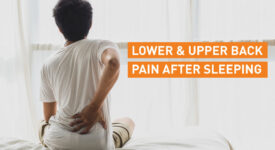Winter orthopaedic disorders like arthritis, joint pain, and muscle stiffness can worsen due to temperature drops, ice conditions, and decreased physical activity. However, with the proper knowledge and methods, you may prevent and relieve orthopaedic pain throughout the colder months. Common sensitivity can increase due to a decline in temperature and changes in atmospheric pressure, making even routine actions uncomfortable. However, recent improvements in orthopaedic treatment have produced creative strategies to address this problem. Another factor contributing to orthopaedic pain in winter is decreased physical activity. Cold weather often discourages outdoor exercise, leading to a sedentary lifestyle that can worsen existing conditions or lead to new ones. Lack of movement can contribute to muscle weakness, joint stiffness, and weight gain, further aggravating orthopedic pain.

Understanding Orthopaedic Pain in winter
Orthopedic pain sufferers may find the winter months to be particularly difficult. Aside from aggravating symptoms, a drop in temperature can also make daily tasks more challenging due to moisture and changes in atmospheric pressure. However, understanding the causes of orthopedic pain in winter and taking proactive measures can help alleviate discomfort and improve overall well-being.
Orthopedic pain influences the outer muscle framework, including bones, joints, muscles, tendons, and ligaments. Conditions like osteoarthritis, rheumatoid joint inflammation, fibromyalgia, and even wounds from falls on frosty surfaces can turn out to be more irksome during the winter because of a few elements:
- Temperature Responsiveness: A chilly climate can tighten joints, prompting expanded solidness and agony in people with joint inflammation. It is far and wide in weight-bearing joints like the knees, hips, and lower back.
- Reduced Actual work: Individuals will often be less dynamic in winter, which can prompt muscle-debilitating and joint solidness. Diminished exercise can fuel muscular agony and lessen joint adaptability.
- Risk of Slips and fall: Cold walkways and elusive surfaces represent a critical gamble of falls and wounds, which can deteriorate previous muscular circumstances or make new ones.

Seeking Professional Help: When to Consult an Orthopedic Specialist
If you’re experiencing orthopedic pain or have sustained an injury that affects your bones, joints, muscles, or ligaments, it may be time to consult an orthopedic specialist. Here are some situations in which seeking professional help from an orthopedic specialist is recommended:
Persistent pain:
If you’ve been experiencing chronic pain in your bones, joints, or muscles that don’t go away with rest or over-the-counter pain medication, it’s wise to consult an orthopedic specialist. They can accurately diagnose the root cause of your pain and provide appropriate treatment options.
Sports injuries:
If you’ve suffered a sports-related injury such as a sprain, strain, dislocation, or fracture, an orthopedic specialist can help evaluate the extent of the injury and provide tailored treatment plans to promote healing and prevent further damage.
Joint problems:
If you’re having difficulty with basic joint movements or experiencing stiffness, swelling, or instability in your joints, it’s advisable to consult an orthopedic specialist. They can assess your condition and determine if there’s an underlying issue such as arthritis, bursitis, or tendonitis.
Reduced mobility:
If you’ve noticed a decline in your ability to move comfortably or perform daily activities due to joint pain or limited range of motion, it’s essential to seek professional help. An orthopedic specialist can recommend appropriate treatments, such as physical therapy or surgical interventions.
Back and neck pain:
If you’re suffering from persistent back or neck pain that affects your daily life and is not responding to conservative treatments like rest and physical therapy, consulting an orthopedic specialist is recommended. They can evaluate your condition and offer specialized treatment options tailored to your needs.
Work-related injuries:
Consulting an orthopedic specialist is crucial if you’ve sustained an injury at work that affects your musculoskeletal system. They can help assess the severity of the injury, guide you through the recovery process, and provide necessary documentation for insurance claims if required.
Remember, it’s always better to avoid caution and consult a specialist if you need clarification on your condition. Orthopedic specialists are highly trained in diagnosing and treating musculoskeletal conditions, ensuring you receive the appropriate care.

Tips for Managing Orthopedic Pain in winter
- Dress Comfortably: Legitimate apparel keeps your joints and muscles warm. Layering up can assist with keeping up with your internal heat level, diminishing the possibilities of firmness and agony.
- Remain Dynamic: While staying inside during a chilly climate is enticing, keeping up with active work is pivotal for overseeing muscular agony. Think about indoor activities, yoga, or swimming to keep your muscles and joints dynamic and adaptable.
- Keep a Solid Eating routine: A decent eating routine wealthy in mitigating food varieties like natural products, vegetables, and omega-3 unsaturated fats can assist with diminishing irritation and lighten muscular torment.
- Heat Treatment: Applying intensity to sore or solid joints and muscles can help. Use warming cushions, hot showers, or heated water jugs to mitigate uneasiness.
- Cold Packs: On the other side, cold packs can assist with lessening aggravation in intense cases. Applying ice packs for brief spans can ease agony and enlarging.
- Torment Drug: Over-the-counter painkillers or endorsed meds, as your medical care supplier suggests, can help oversee muscular agony.
- Non-intrusive treatment: Talk with a specialist who can give custom-fitted activities and methods to work on joint portability and diminish torment.
- Fall Counteraction: To keep away from slips and falls, wear suitable footwear with significant foothold, use handrails on frosty surfaces, and consider utilizing ice spikes or grippers on your shoes.
- Keep a Solid Weight: Overabundance of body weight can include pressure joints and worsening muscular circumstances. Keeping a sound load through diet and exercise can assist with easing torment.
- Counsel a subject matter expert: If your muscular torment deteriorates during winter or becomes deplorable, seek guidance from a muscular-trained professional. They can give custom-made treatment choices, including infusions or careful intercessions if fundamental.
Embracing Winter Comfortably with Orthopedic Pain
Winter can be challenging for those dealing with orthopedic pain, but there are ways to embrace the season comfortably. Here are some tips to help you navigate the winter months with less discomfort:
- Maintaining warmth is advisable: Low temperatures can exacerbate discomfort in joints and muscles. Dressing in warm attire, including layered clothing, thick socks, and gloves, is recommended to regulate body temperature.
- Utilize heat therapy: Applying heat to areas experiencing pain can offer temporary relief. It is worth considering using heating pads, hot water bottles, or heat packs to alleviate discomfort in joints and muscles. However, adhering to safety guidelines and avoiding prolonged exposure to prevent burns is essential.
- Maintain an active lifestyle: Despite the allure of hibernation during winter, it is crucial to remain physically active to manage orthopedic pain effectively. Engaging in low-impact activities such as walking, swimming, or yoga can help keep joints mobile and muscles strong.
- Adapt your surroundings: It is advisable to adjust your living environment to ensure it is suitable for the winter season. Includes ensuring adequate heating and eliminating drafts in your living space. Rugs or mats on slippery surfaces can also help prevent falls that may exacerbate pain.
- Consider the use of orthopedic aids: Depending on your specific condition, orthopedic aids such as braces, supports, or shoe inserts may offer additional support and alleviate pain during winter activities.
Conclusion
Orthopedic pain in the winter can be challenging to manage, but with the correct approaches and preventative measures, you can successfully manage and ease discomfort. To avoid slips and falls, remember to dress warmly, keep active, eat a healthy diet, and take the appropriate safety precautions. Despite orthopedic difficulties, consulting with healthcare professionals and specialists can offer specific solutions to assist you in taking advantage of a more comfortable winter season. You can reduce discomfort and take advantage of a more pain-free winter season by heeding these recommendations and effectively managing your condition. Working closely with your healthcare practitioner to determine the best course of action for your unique orthopedic problem is crucial because individual responses to weather and pain management techniques might differ. You can stay active and independent with the proper care and attention.









